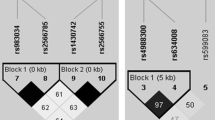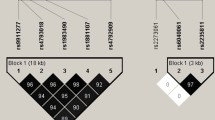Abstract
Summary
Previously, homozygous deletion of the UGT2B17 gene has shown association with hip fracture. Using a high-throughput qRT-PCR assay, we genotyped UGT2B17 copy number variation (CNV) in 1,347 elderly Caucasian women and examined for effects on bone phenotypes. We found no evidence of association between UGT2B17 CNV and osteoporosis risk in this population.
Introduction
Genetic studies of osteoporosis commonly examine SNPs in candidate genes or whole genome analyses, but insertions and deletions of DNA, collectively called CNV, also comprise a large amount of the genetic variability between individuals. Previously, homozygous deletion of the UGT2B17 gene in CNV 4q13.2, which encodes an enzyme that mediates the glucuronidation of steroid hormones, has shown association with the risk of hip fracture.
Methods
We used a quantitative real-time PCR assay for genotyping the UGT2B17 CNV in a well-characterized population study of 1,347 Caucasian women aged 75.2 ± 2.7 years (mean ± SD), to assess the effect of the CNV on bone mass density (BMD) at the total hip site and osteoporosis risk.
Results
The UGT2B17 CNV distribution was consistent with the expected Hardy–Weinberg distribution and not different from frequencies previously reported in a Caucasian population. Data from ANCOVA of age- and weight-adjusted BMD for UGT2B17 CNV genotype showed no significant difference between genotype groups. Individuals with homozygous or heterozygous deletion of the UGT2B17 gene showed no increased risk of incident fragility fracture.
Conclusions
These data suggest that quantitative real-time PCR is a rapid and efficient technique for determination of candidate CNVs, including the UGT2B17 CNV; however, we found no evidence of an effect of UGT2B17 CNV on osteoporosis risk in elderly Caucasian women.
Similar content being viewed by others
References
Richards J, Rivadeneira F, Inouye M et al (2008) Bone mineral density, osteoporosis, and osteoporotic fractures: a genome-wide association study. Lancet 371:1505–1512
Rivadeneira F, Styrkársdottir U, Estrada K et al (2009) Twenty bone-mineral-density loci identified by large-scale meta-analysis of genome-wide association studies. Nat Genet 41:1199–1206
Yang TL, Chen XD, Guo Y et al (2008) Genome-wide copy-number-variation study identified a susceptibility gene, UGT2B17, for osteoporosis. Am J Hum Genet 83:663–674
Brasch-Andersen C, Christiansen L, Tan Q et al (2004) Possible gene dosage effect of glutathione-S-transferase on atopic asthma: using real-time PCR for quantification of GSTM1 and GSTT1 gene copy numbers. Hum Mutat 24:208–214
Ivaschenko TE, Sideleva OG, Baranov VS (2002) Glutathione-S-transferase micro and theta gene polymorphisms as new risk factors of atopic bronchial asthma. J Mol Med 80:39–43
Fanciulli M, Norsworthy PJ, Petretto E et al (2007) FCGR3B copy number variation is associated with susceptibility to systemic, but not organ-specific, autoimmunity. Nat Genet 39:721–723
McKinney C, Merriman ME, Chapman PT et al (2008) Evidence for an influence of chemokine ligand 3-like 1 (CCL3L1) gene copy number on susceptibility to rheumatoid arthritis. Ann Rheum Dis 67:409–413
Yang Y, Chung EK, Wu YL et al (2007) Gene copy-number variation and associated polymorphisms of complement component C4 in human systemic lupus erythematosus (SLE): low copy number is a risk factor for and high copy number is a protective factor against SLE susceptibility in European Americans. Am J Hum Genet 80:1037–1054
Walsh T, McClellan JM, McCarthy SE et al (2008) Rare structural variants disrupt multiple genes in neurodevelopmental pathways in schizophrenia. Science 320:539–543
Wilson GM, Flibotte S, Chopra V et al (2006) DNA copy-number analysis in bipolar and schizophrenia reveals aberrations in genes involved in glutamate signalling. Hum Mol Genet 15:743–749
Sebat J, Lakshmi B, Malhotra D et al (2007) Strong association of de novo copy number mutations with autism. Science 316:445–449
Weiss LA, Shen Y, Korn JM et al (2008) Association between microdeletion and microduplication at 16p11.2 and autism. N Engl J Med 358:667–675
Wilson W 3rd, Pardo-Manuel de Villena F, Lyn-Cook BD et al (2004) Characterization of a common deletion polymorphism of the UGT2B17 gene linked to UGT2B15. Genomics 84:707–714
Xie C, Tammi MT (2009) CNV-seq, a new method to detect copy number variation using high-throughput sequencing. BMC Bioinform 10:80
Elson DA, Thurston G, Huang LE et al (2001) Induction of hypervascularity without leakage or inflammation in transgenic mice overexpressing hypoxia-inducible factor-1 alpha. Genes Dev 15:2520–2532
Rose-Zerilli MJ, Barton SJ, Henderson AJ et al (2009) Copy-number variation genotyping of GSTT1 and GSTM1 gene deletions by real-time PCR. Clin Chem 55:1680–1685
Bruce DG, Devine A, Prince RL (2002) Recreational physical activity levels in healthy older women: the importance of fear of falling. JAGS 50:84–89
Prince RL, Devine A, Dhaliwal SS et al (2006) Effects of calcium supplementation on clinical fracture and bone structure. Arch Intern Med 166:869–875
Bollerslev J, Wilson SG, Dick IM et al (2004) Calcium-sensing receptor gene polymorphism A986S does not predict serum calcium level, bone mineral density, calcaneal ultrasound indices, or fracture rate in a large cohort of elderly women. Calcif Tissue Int 74:12–17
Dick IM, Devine A, Marangou A et al (2002) Apolipoprotein E4 is associated with reduced calcaneal quantitative ultrasound measurements and bone mineral density in elderly women. Bone 31:497–502
Rozen S, Skaletsky H (2000) Primer3 on the WWW for general users and for biologist programmers. Methods Mol Biol 132:365–386
Kent WJ, Sugnet CW, Furey TS et al (2002) The human genome browser at UCSC. Genome Res 12:996–1006
Pfaffl MW (2001) A new mathematical model for relative quantification in real-time RT-PCR. Nucleic Acids Res 29:e45
Purcell S, Cherny SS, Sham PC (2003) Genetic power calculator: design of linkage and association genetic mapping studies of complex traits. Bioinformatics 19:149–150
Turgeon D, Carrier JS, Levesque E et al (2001) Relative enzymatic activity, protein stability, and tissue distribution of human steroid-metabolizing UGT2B subfamily members. Endocrinology 142:778–787
Park J, Chen L, Ratnashinge L et al (2006) Deletion polymorphism of UDP-glucuronosyltransferase 2B17 and risk of prostate cancer in African American and Caucasian men. Cancer Epidemiol Biomarkers Prev 15:1473–1478
Karypidis AH, Olsson M, Andersson SO et al (2008) Deletion polymorphism of the UGT2B17 gene is associated with increased risk for prostate cancer and correlated to gene expression in the prostate. Pharmacogenomics J 8:147–151
Jakobsson J, Ekstrom L, Inotsume N et al (2006) Large differences in testosterone excretion in Korean and Swedish men are strongly associated with a UDP-glucuronosyl transferase 2B17 polymorphism. J Clin Endocrinol Metab 91:687–693
Xue Y, Sun D, Daly A et al (2008) Adaptive evolution of UGT2B17 copy-number variation. Am J Hum Genet 83:337–346
Conflicts of interest
None.
Author information
Authors and Affiliations
Corresponding author
Rights and permissions
About this article
Cite this article
Chew, S., Mullin, B.H., Lewis, J.R. et al. Homozygous deletion of the UGT2B17 gene is not associated with osteoporosis risk in elderly Caucasian women. Osteoporos Int 22, 1981–1986 (2011). https://doi.org/10.1007/s00198-010-1405-0
Received:
Accepted:
Published:
Issue Date:
DOI: https://doi.org/10.1007/s00198-010-1405-0




